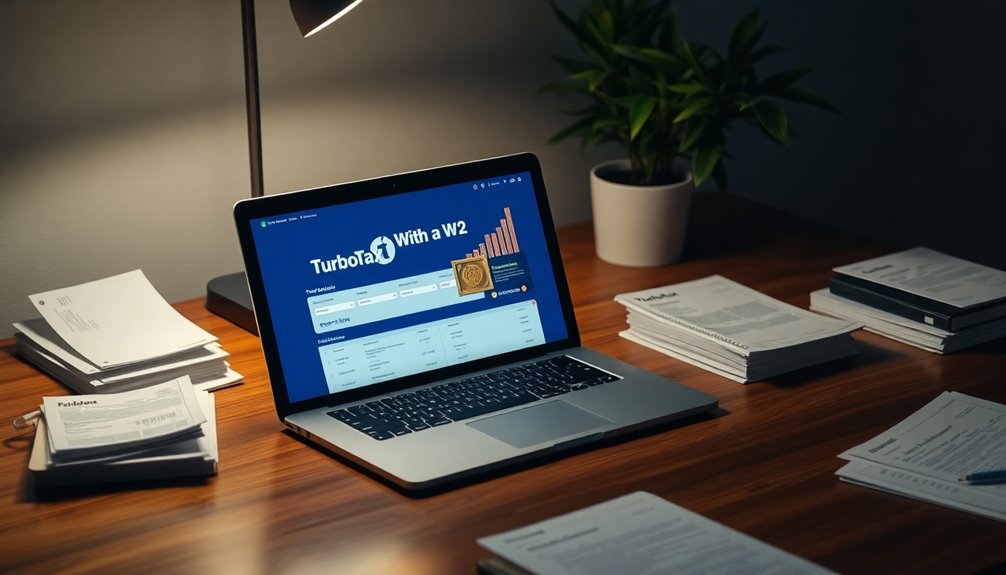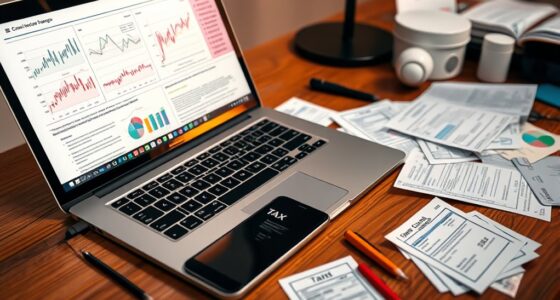To keep track of mileage for taxes, start by choosing a tracking method that works for you, like a mileage tracking app, manual log, or spreadsheet. Record each trip immediately, noting the date, destination, purpose, and odometer readings. Make sure to distinguish between business and personal miles, updating your log regularly to maintain accuracy. Follow IRS guidelines for documentation, retaining your records for at least three years. By keeping meticulous records, you'll maximize potential deductions. There's a lot more you can do to ensure you're tax-ready and optimize your mileage deductions effectively.
Key Takeaways
- Use mileage tracking apps for automatic logging and IRS-compliant reports, ensuring accuracy in documenting trips.
- Record the odometer reading on January 1st and log each trip immediately after completion for accurate records.
- Distinguish between business and personal miles, updating your log frequently to maintain clarity and compliance.
- Retain detailed records of all business-related expenses, including receipts for tolls, parking, and fuel, to maximize deductions.
- Follow IRS guidelines for record retention and documentation, keeping records for at least three years to prepare for audits.
Choosing a Mileage Tracking Method
When it comes to choosing a mileage tracking method, you've got several solid options to consider. You can go the manual route, using a physical logbook or notebook. This requires you to jot down the date, purpose of the trip, starting and ending locations, and odometer readings for each journey.
While this method can be straightforward, it's time-consuming and prone to human error.
If you prefer a more digital approach, you might opt for spreadsheets like Excel or Google Sheets. This option allows for organized data entry and can reduce errors if you use formulas correctly.
However, it still needs regular updates and isn't as automated as some other methods. For maximum efficiency, consider mileage tracking apps. These utilize GPS to log your miles automatically and can classify trips as business or personal with minimal input from you. Additionally, using apps can help ensure compliance with IRS mileage reimbursement rules, making your tracking efforts more effective.
They also generate IRS-compliant reports and integrate seamlessly with accounting software, saving you time and reducing the risk of errors.
Ultimately, the best choice depends on your personal needs and how much time you want to invest in tracking your mileage.
Setting Up Initial Records

To effectively track your mileage for tax purposes, it's important to set up initial records right from the start of the tax year. Begin by noting your odometer reading on January 1st. Record this reading in a reliable log or app; it serves as the baseline for calculating your total business miles. This step is crucial, whether you choose the standard mileage method or the actual expense method.
Next, create a mileage log template. Include columns for the date, destination, purpose, total trip mileage, and any related expenses like gas and tolls. Use this template consistently, whether it's pen and paper or an electronic spreadsheet. Make sure it captures all necessary information for IRS compliance.
Identify the essential details to record: the date of each trip, starting and ending odometer readings, trip purpose, and total miles driven. Regularly update your records to avoid missing any business trips. Additionally, ensure you are aware of the current mileage reimbursement rates to maximize your deductions when filing taxes.
Ensure accuracy by backing your data with evidence, like odometer readings and receipts. Lastly, retain all documentation for at least three years in case of an IRS audit.
Recording Each Trip

Recording each trip accurately is essential for maximizing your tax deductions and staying compliant with IRS regulations. Start by noting the date of each business trip, ensuring it matches your trip log. Update this log immediately after each trip to avoid errors, and include the time of departure and arrival when necessary.
Next, be sure to log the starting and ending locations, along with the starting and ending odometer readings. Calculate the total mileage by subtracting the starting reading from the ending reading. Reset the odometer's trip counter before each new trip to maintain accuracy, and double-check your calculations regularly. Additionally, utilizing automatic trip recording can streamline this process and reduce the chances of forgetting to log trips.
Don't forget to specify the purpose of each trip, whether it's business or personal, and include any relevant details, like the number of stops and their durations. Additionally, record any trip-related expenses, such as tolls, parking, and fuel—keeping receipts for these can be beneficial for tax purposes.
If idling time is significant, log that as well. Lastly, distinguish between business and personal miles, updating your log frequently to ensure it's comprehensive and accurate.
Using Mileage Tracking Apps
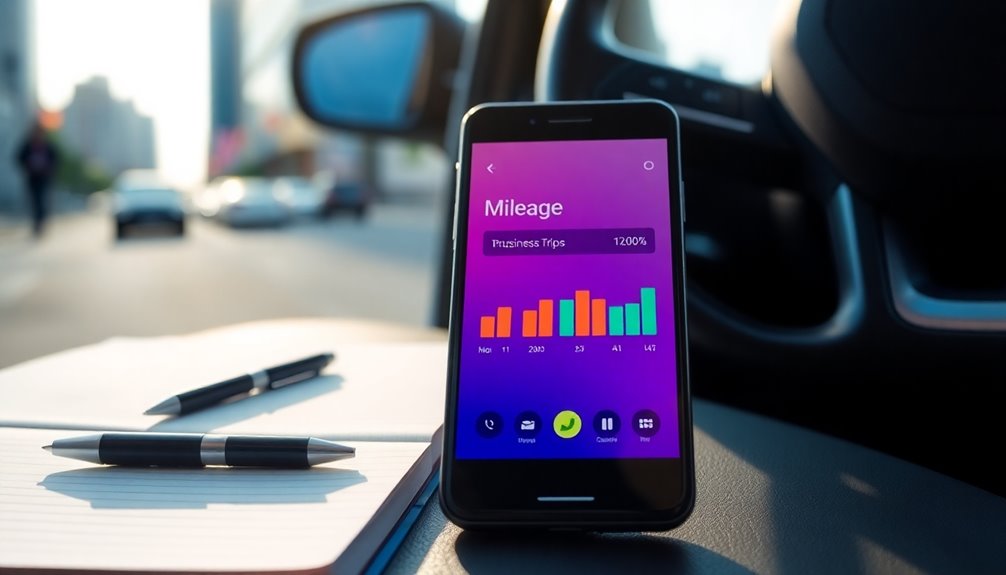
Using mileage tracking apps can simplify the process of logging your business trips, ensuring you capture every mile accurately. These apps automatically record your mileage using GPS, detecting trips and creating logs that comply with IRS standards. You can easily label trips as business or personal, saving you time and effort.
Most mileage tracking apps come with user-friendly mobile and web dashboards, making it easy to monitor your trips. Features like geofencing and route optimization enhance your tracking experience. Many apps also integrate seamlessly with accounting software like FreshBooks and QuickBooks, allowing for streamlined expense tracking. You can even connect your bank accounts and credit cards for a comprehensive view of your expenses. Additionally, automatic mileage tracking is a prominent feature in many of these apps, making record-keeping even more efficient.
Additionally, these apps generate IRS-compliant reports, providing detailed analytics on your vehicle usage. This ensures your mileage logs are accurate, which is crucial for maximizing tax deductions.
Most mileage tracking apps offer free trials or versions, but premium plans provide advanced features and VIP customer support, making it worth considering if you drive frequently for business. With these tools, you can focus on your work while staying organized and compliant.
Preparing for Tax Filing

Preparing for tax filing means ensuring your mileage records are accurate and complete. To do this, start by recording essential information for each trip. Make sure you note the date, purpose, total miles driven, and odometer readings at both the start and end of the trip.
Keeping these records up-to-date is crucial; try to log your mileage at or near the time of each trip and update your logs at least weekly. Use a dedicated notebook or spreadsheet for your mileage logs, and clearly distinguish between business and personal mileage. It's important to remember that the IRS provides standard mileage rates for deductible travel categories, which can help you maximize your deductions.
It's also wise to keep your total annual mileage and total business mileage documented. Remember, the IRS requires timely and contemporaneous logs, so avoid logging everyday commuting miles to your regular worksite.
To ensure IRS compliance, follow their guidelines closely. Consider using IRS-provided mileage log templates to help you stay on track.
Finally, keep your records for at least three years in case of an audit. With these steps, you'll be well-prepared for tax filing and can confidently report your mileage deductions.
Standard Mileage Method
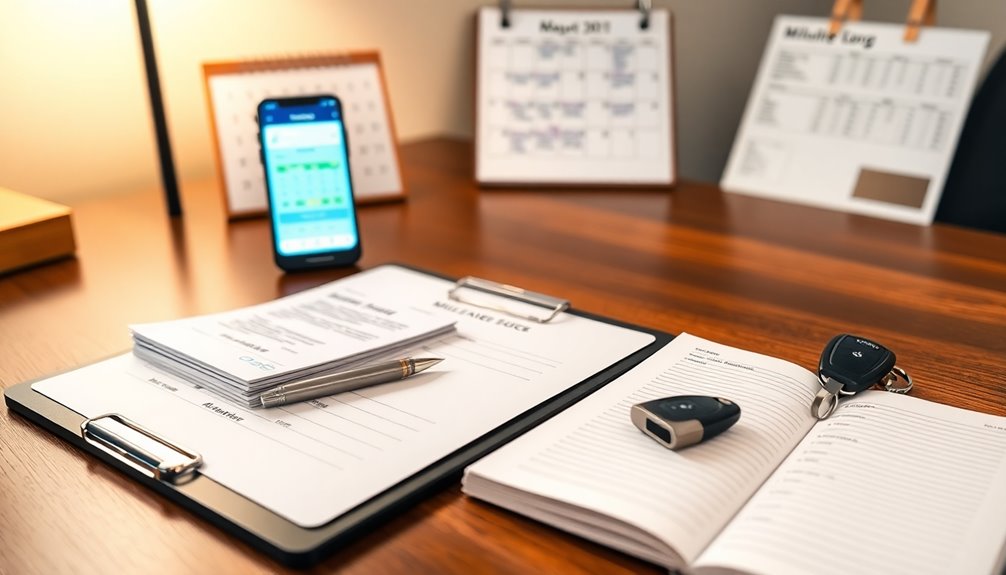
Choosing the right method for deducting your vehicle expenses can significantly impact your tax savings. The Standard Mileage Method is an excellent option if you're eligible. You must choose this method in the first year you use your car for business, whether you own or lease it.
However, if you claimed certain depreciation deductions or if you're operating a fleet of more than five vehicles, you'll need to look elsewhere.
To calculate your deduction, simply multiply your business miles by the IRS standard mileage rate—67 cents per mile for 2024. For example, if you drove 5,000 business miles, your deduction would be $3,350. This method covers all expenses related to running your vehicle for business and doesn't require you to track individual costs.
Be diligent about record-keeping. You need to differentiate between business and personal mileage, noting the date, purpose, and total miles for each trip. Keeping a mileage log or using tracking apps can simplify this process. Additionally, it's important to remember that the standard mileage rate can change annually, so always verify the current rate to maximize your deduction.
Actual Expense Method
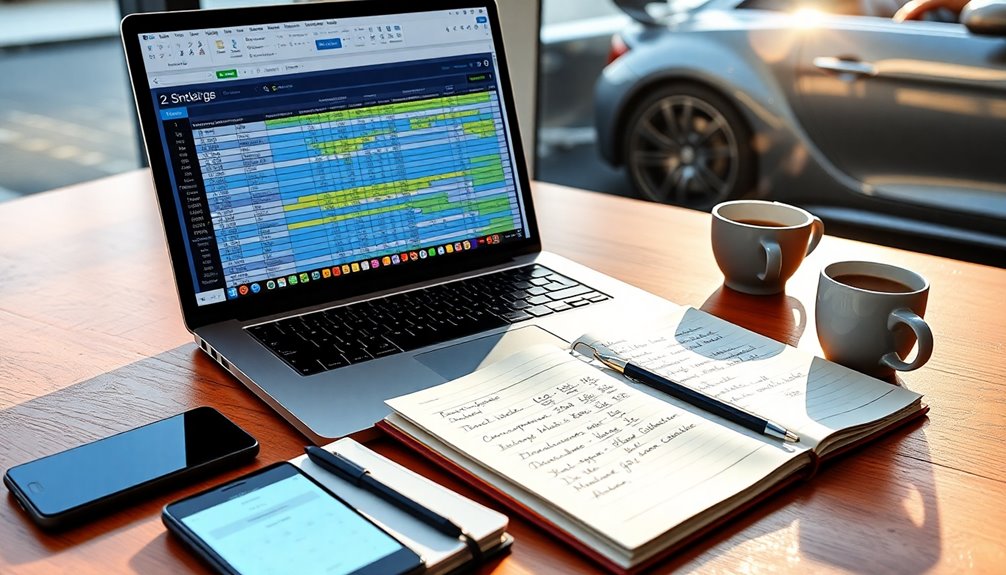
The Actual Expense Method can be a smart choice for those who incur significant vehicle expenses and have lower business mileage. This method allows you to deduct all eligible expenses related to your vehicle. These include lease payments, automotive insurance, fuel, maintenance like oil changes and tire rotations, new tires, and repairs. Additionally, the IRS recommends calculating both methods to determine which provides a higher deduction.
To effectively use this method, you need to track all vehicle expenses meticulously. Keep detailed records, including receipts, and note the percentage of your vehicle's use for business purposes.
Be sure to track both business and total miles driven throughout the year, and maintain these records for at least three years in case of an audit.
When calculating your deduction, add up all the expenses and multiply by the business use percentage. Using a mileage tracker app can help you categorize trips as business or personal, making record-keeping easier.
Common Mistakes to Avoid

Keeping track of mileage for tax deductions can be a tricky business, and avoiding common mistakes is essential for maximizing your benefits. One major pitfall is failing to keep detailed records of all your business drives. Omitting even a few trips each week can lead to significant losses in potential deductions over time. To prevent this, consider using a tool like MileIQ that ensures automatic tracking of mileage and helps maintain comprehensive records.
Make sure to document the date, destination, purpose, total trip mileage, and any related expenses like gas and tolls.
Another common mistake is confusing personal and business trips. Only report drives that are strictly business-related; personal trips should never be included. Clearly differentiate between the two and include the purpose of each trip to ensure accurate categorization.
Don't forget to document the business purpose of your trips. Each entry in your mileage log should explain why the trip was necessary for your business. Failure to do so can raise red flags with the IRS.
Finally, neglecting to keep receipts for tolls and parking can hurt your deductions. These expenses add up quickly, so maintain accurate records and receipts along with your mileage log to maximize your tax benefits.
Best Practices for Accuracy
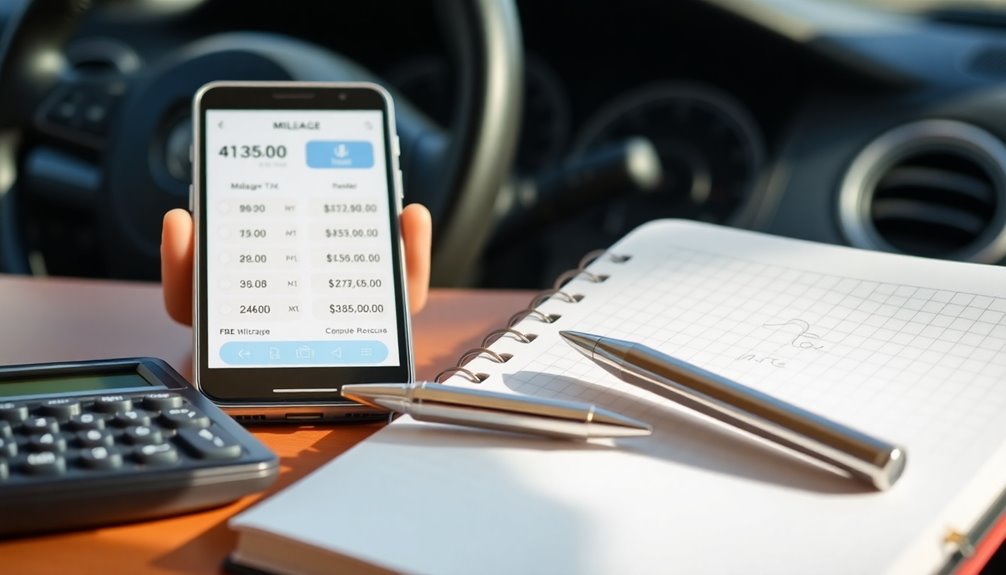
Accurate mileage tracking starts with a detailed driving log. Make it a habit to record the date of each business trip alongside the starting and ending odometer readings. Don't forget to document the purpose of each trip, whether it's a client visit or a business-related errand. Always log the starting and ending points of your journeys, and update your log regularly, ideally right after each trip. At the start of the tax year, record your odometer reading to establish a baseline. Then, at the end of the year, log that final reading to tally your total business mileage. Consider using the "trip" setting on your odometer to track individual trips accurately. Keep meticulous records of all business-related expenses, including gas, parking, and tolls. Note the date, merchant name, and a brief description for each item. Retain receipts, as they may be necessary for audits. Finally, leverage technology by using mileage tracking tools. Whether you choose a manual log, spreadsheet, or GPS-enabled app, ensure that your chosen method is consistent and meets IRS requirements for accuracy. Additionally, maintaining a comprehensive driving log is essential for maximizing potential tax deductions related to business mileage.
Frequently Asked Questions
Can I Track Mileage for Personal Trips as Well?
You can track mileage for personal trips, but keep in mind that it won't qualify for deductions.
If you're monitoring your overall driving habits or planning trips, logging personal mileage can be useful. You might find it helpful for budgeting or understanding your travel patterns.
Just remember to separate your personal trips from any business-related travel if you ever need to report for tax purposes.
How Long Should I Keep My Mileage Records?
You should keep your mileage records for at least seven years.
This timeframe helps you stay prepared in case of an audit, which can happen for returns filed within the last three years.
If there are significant accounting errors, that window can extend to six years.
Are There Specific Apps Recommended for Mileage Tracking?
If you're looking for specific apps to track your mileage, you've got some great options.
Fyle automates tracking and integrates with accounting software, while Everlance offers GPS accuracy and IRS-ready reports.
Hurdlr combines mileage tracking with tax estimation, and MileageWise ensures accurate logs with minimal effort.
FreshBooks and Stride provide automated recording and expense insights, making it easier to manage your trips.
Choose one that fits your needs!
What if I Forget to Log a Trip?
If you forget to log a trip, don't panic.
Start by reviewing your calendar or receipts from that day to jog your memory. You can also estimate the mileage using mapping tools.
It's crucial to recreate as much detail as possible, including the date, purpose, and distance.
Going forward, consider using a mileage tracking app to simplify the process and ensure you record trips accurately in real-time.
Can I Switch Tracking Methods Mid-Year?
Yes, you can switch tracking methods mid-year, but be careful.
Make sure your new method is compatible with your previous one to avoid data inconsistencies. Keep all records updated with essential information like dates and mileage to maintain a clear log.
If you use a hybrid approach, regularly consolidate your data to prevent errors.
Conclusion
Keeping track of your mileage for taxes doesn't have to be a hassle. By choosing a tracking method that works for you, setting up initial records, and recording each trip diligently, you can simplify the process. Using mileage tracking apps can save you time and ensure accuracy. Remember to prepare properly for tax filing by understanding both the standard and actual expense methods. Avoid common mistakes, and you'll make tax season a breeze!


